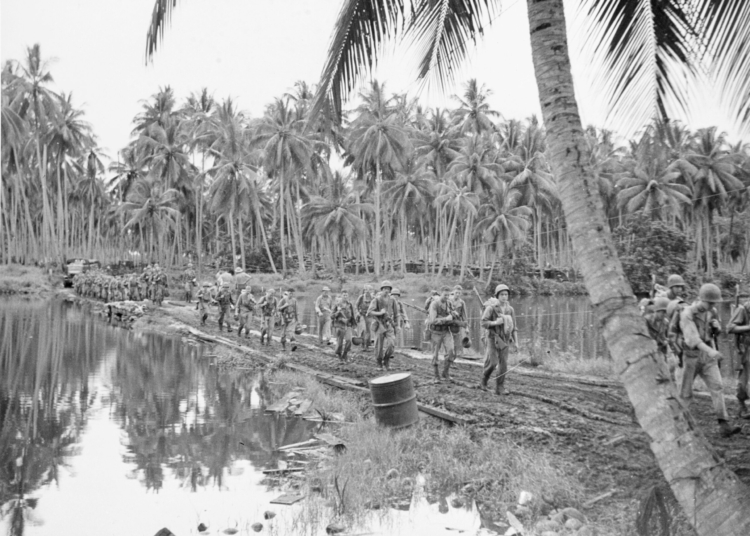The Battle of Guadalcanal, fought between the United States and Japan during World War II, marked a pivotal turning point in the Pacific theater. This battle was the Allies’ first major offensive against Japanese-held territory and lasted from August 7, 1942, to February 9, 1943. The strategically important island of Guadalcanal was the focus of the campaign, with both sides engaging in arduous and bloody fighting. The United States ultimately secured a victory, aided by naval battles and the establishment of airfields on Guadalcanal. This triumph shattered the myth of Japanese invincibility and paved the way for future Allied offensives.
The Battle of Guadalcanal: A Pivotal American Victory in the Pacific
Introduction
The Battle of Guadalcanal, which took place in the Pacific theater of World War II, was a crucial turning point in the conflict. Fought between the United States and the Empire of Japan, this battle marked the first major offensive by the Allies against Japanese-held territory. Lasting from August 7, 1942, to February 9, 1943, this arduous campaign resulted in an American victory and solidified their foothold in the Pacific region.
Background
After the devastating Japanese attack on Pearl Harbor in December 1941, the United States quickly found itself at war with Japan. The battle for control of the Pacific became a top priority. The Soloman Islands, specifically the island of Guadalcanal, were seen as vital strategic locations due to their proximity to major shipping routes and the potential to establish airfields. Taking control of Guadalcanal would not only neutralize Japanese air and naval power but also allow the Allies to launch counteroffensives against Japan.
The Battle Begins
On August 7, 1942, the United States launched the amphibious assault on Guadalcanal, codenamed Operation Watchtower. Under the cover of darkness, the U.S. Marines successfully landed on the island’s northern shore, facing light resistance from the Japanese forces stationed there. However, the following days saw fierce fighting as both sides struggled to gain the upper hand.
A Bloody Campaign
The Battle of Guadalcanal quickly turned into a grueling and bloody campaign. The Japanese, determined to retain control of the island, launched several counterattacks to push the Americans back into the sea. Despite being heavily outnumbered, the U.S. Marines showcased their resilience and tenacity, fighting against harsh jungle conditions, a formidable enemy, and limited supplies.
The Naval Battle
Simultaneously, the Battle of Guadalcanal witnessed several fierce naval engagements, with both sides deploying their aircraft carriers, battleships, and cruisers. The U.S. Navy successfully repelled a series of Japanese attempts to reinforce their troops on Guadalcanal, denying them crucial supplies and reinforcements. The naval battle off Guadalcanal, known as the Naval Battle of Guadalcanal, proved to be a decisive turning point as it halted the Japanese attempts to retake the island.
Air Superiority
The capture and subsequent development of airfields on Guadalcanal played a vital role in turning the tide of the battle. The U.S. Army Air Forces and Marine Corps Aviation operated from these airfields, allowing them to gain air superiority over the Japanese. This aerial advantage enabled the Americans to provide close air support to their ground forces, disrupting Japanese operations and weakening their morale.
Japanese Retreat
By November 1942, the Japanese realized the futility of their efforts to recapture Guadalcanal. Despite their initial successes, they were unable to break the American hold on the island. The constant bombing by U.S. aircraft and the overwhelming superiority of American naval forces forced the Japanese to withdraw their remaining troops and abandon their positions on Guadalcanal. This marked a significant victory for the United States.
Legacy
The Battle of Guadalcanal had far-reaching consequences in the Pacific theater during World War II. It shattered the myth of Japanese invincibility and confidence, proving that the tide of the war in the Pacific had turned in favor of the Allies. The American victory at Guadalcanal also marked a major shift in strategy, with the Allies adopting an offensive approach to retake Japanese-held territory.
Conclusion
The Battle of Guadalcanal stands as a pivotal moment in the history of World War II and the Pacific theater. Through tenacious fighting, allied forces secured a crucial victory over Japan, setting the stage for future American offensives in the Pacific. The lessons learned from this campaign would shape the direction of the war, ultimately leading to the complete defeat of the Empire of Japan.













